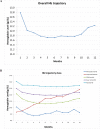Hemoglobin level trajectories in the early treatment period are related with survival outcomes in patients with breast cancer
- PMID: 27906669
- PMCID: PMC5352078
- DOI: 10.18632/oncotarget.13679
Hemoglobin level trajectories in the early treatment period are related with survival outcomes in patients with breast cancer
Abstract
Hemoglobin (Hb) levels are reportedly related with treatment outcomes and survival in patients of breast cancer. However, the long-term change in Hb levels after treatment and the effects of Hb on survival remain unknown. This retrospective cohort study enrolled 1931 breast cancer patients with pathological stage I-IV between 1/1/2003 and 12/31/2013. Latent class modeling was used to identify trajectories in monthly Hb levels over time. The primary endpoint was 10-year cancer-related death. We identified 5 distinct Hb trajectories: persistent anemia (5.6 %; n = 109), improved anemia (4.8 %, n = 93), mild anemia (21.0%; n = 406), low normal Hb (46.6 %; n = 899), and normal Hb (21.9%; n = 424). Compared with the normal-Hb group, trajectories with low Hb levels had worst 10-year survival. The adjusted hazard ratios were 1.79(95% CI, 0.91-3.53) for the improved anemia group, 1.09(95% CI, 0.68-1.74) for the mild anemia group, 1.06 (95% CI, 0.71-1.60) for the low normal Hb group, and 2.19(95% CI 1.28-3.75) for the persistent anemia group. Our findings show there are five Hb level trajectories during breast cancer treatment. The anemia Hb level trajectory during the first 12 months after treatment reflect the worst cancer-related 10-year survival in breast cancer patients.
Keywords: breast cancer; hemoglobin; survival; trajectory.
Conflict of interest statement
The authors and their families have no commercial associations or sources of support that might pose a conflict of interest. No benefits in any form have been or will be received from a commercial party related directly or indirectly to the subject of this manuscript.
Figures


References
-
- Ludwig H. Anemia of hematologic malignancies: what are the treatment options? Semin Oncol. 2002;29:45–54. - PubMed
-
- Caro JJ, Salas M, Ward A, Goss G. Anemia as an independent prognostic factor for survival in patients with cancer: a systemic, quantitative review. Cancer. 2001;91:2214–2221. - PubMed
-
- Tarnawski R, Skladowski K, Maciejewski B. Prognostic value of hemoglobin concentration in radiotherapy for cancer of supraglottic larynx. Int J Radiat Oncol Biol Phys. 1997;38:1007–1011. - PubMed
-
- Hamai Y, Hihara J, Taomoto J, Yamakita I, Ibuki Y, Okada M. Hemoglobin level influences tumor response and survival after neoadjuvant chemoradiotherapy for esophageal squamous cell carcinoma. World J Surg. 2014;38:2046–2051. - PubMed
MeSH terms
Substances
LinkOut - more resources
Full Text Sources
Other Literature Sources
Medical

